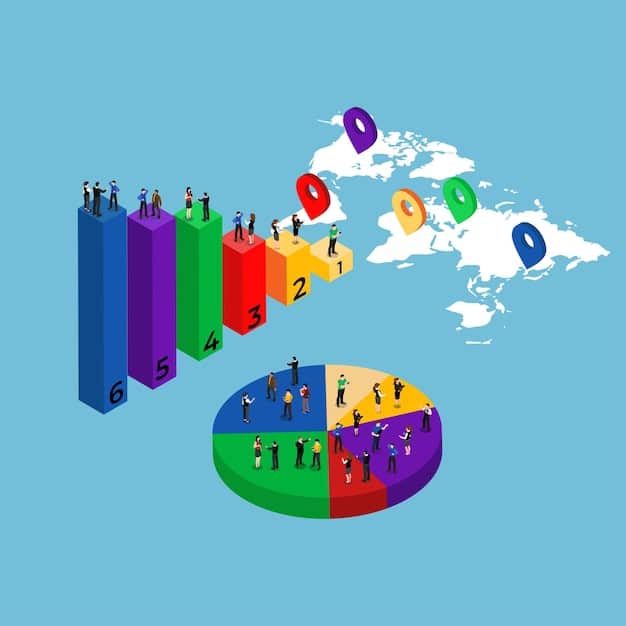The Future of US Foreign Aid: Geopolitical Analysis and Resource Allocation

The Future of US Foreign Aid: A Geopolitical Analysis of Resource Allocation examines how evolving global dynamics, shifting national interests, and emerging challenges are reshaping the priorities and strategies of US foreign aid distribution.
The landscape of international relations is constantly shifting, and with it, the nature of the Future of US Foreign Aid: A Geopolitical Analysis of Resource Allocation. Understanding these changes is crucial for policymakers, economists, and anyone interested in global development.
Understanding the Geopolitical Context of US Foreign Aid
US foreign aid is not simply an act of charity. It’s a strategic tool deployed to advance US interests, promote stability, and counter the influence of rival powers. Understanding the geopolitical context is key to comprehending its future trajectory.
The Shifting Global Order
The rise of China, the resurgence of Russia, and the increasing assertiveness of regional powers are reshaping the global order. This multipolar world presents both challenges and opportunities for US foreign aid.
- China’s Belt and Road Initiative (BRI) offers an alternative model of development finance, challenging the traditional dominance of US aid.
- Russia’s use of disinformation and political interference undermines democratic institutions, requiring a more nuanced approach to aid delivery.
- Regional conflicts and humanitarian crises demand immediate responses, straining resources and requiring strategic prioritization.
US National Interests and Foreign Aid
US foreign aid is intrinsically linked to its national interests, including security, economic prosperity, and the promotion of democratic values. These interests often guide the allocation of resources to specific countries and regions.
For example, aid to countries bordering conflict zones may be prioritized to prevent instability from spilling over. Similarly, aid to countries with strategic resources may aim to secure access and promote economic partnerships.

Strategic Priorities in US Foreign Aid Allocation
US foreign aid is allocated based on a complex set of strategic priorities. These priorities are shaped by both domestic considerations and external pressures.
Economic Development
Promoting sustainable economic development is a key goal of US foreign aid. This includes investments in infrastructure, education, and healthcare, as well as support for private sector growth.
Supporting economic development creates opportunities for trade and investment, benefiting both the recipient country and the US. It also reduces poverty and inequality, fostering stability and reducing the likelihood of conflict.
Security Assistance
Security assistance is another major component of US foreign aid. This includes military training, equipment, and support for counter-terrorism efforts. The aim is to bolster the capacity of partner countries to defend themselves and maintain stability.
However, security assistance can also have unintended consequences, such as fueling arms races and undermining human rights. It’s important to carefully consider the potential risks and benefits before providing security assistance.
Emerging Challenges and Opportunities
The future of US foreign aid is shaped by emerging challenges and opportunities, including climate change, pandemics, and technological advancements.
Climate Change
Climate change poses a significant threat to global stability and prosperity. Rising sea levels, extreme weather events, and food insecurity can exacerbate existing tensions and lead to conflict. US foreign aid can play a critical role in helping vulnerable countries adapt to climate change and transition to a low-carbon economy.
Investing in renewable energy, sustainable agriculture, and disaster preparedness can build resilience and reduce the risk of climate-related crises.
Global Health Security
The COVID-19 pandemic highlighted the importance of global health security. US foreign aid can strengthen health systems in developing countries, improve disease surveillance, and support vaccine development and distribution.
- Investing in healthcare infrastructure: Improving hospitals, clinics, and healthcare worker training.
- Supporting disease surveillance: Enhancing early warning systems for emerging infectious diseases.
- Promoting vaccine equity: Ensuring equitable access to vaccines for all countries.
Technological Innovation
Technological innovation offers new opportunities to improve the effectiveness of US foreign aid. Digital technologies can enhance transparency, reduce corruption, and improve service delivery.
For example, mobile banking can provide access to financial services for people in remote areas. Digital platforms can connect farmers to markets and provide them with information on best practices. However, it is also crucial to bridge the digital divide, ensuring equitable access to technology and digital literacy.

The Role of Multilateralism and Partnerships
US foreign aid is most effective when it is delivered in partnership with other countries and international organizations. Multilateralism allows for burden-sharing, maximizes impact, and promotes global cooperation.
Working with International Organizations
The United Nations, the World Bank, and the International Monetary Fund are key partners in the delivery of US foreign aid. These organizations have the expertise and resources to address complex global challenges.
However, multilateral organizations can also be bureaucratic and inefficient. It’s important to reform these institutions to make them more effective and accountable.
Building Partnerships with Civil Society
Civil society organizations (CSOs) play a crucial role in delivering aid at the grassroots level. CSOs have deep local knowledge and can reach marginalized communities that are often excluded from government programs.
Supporting CSOs can empower local communities, promote good governance, and ensure that aid reaches those who need it most.
The Future of US Foreign Aid: A Geopolitical Analysis of Resource Allocation – Future Trends
Looking ahead, several trends are likely to shape the future of US foreign aid, impacting how resources are allocated and the strategies employed.
Increased Focus on Strategic Competition
The intensifying competition with China and Russia will likely lead to a greater emphasis on strategic competition in the allocation of US foreign aid. Aid will be increasingly used to counter the influence of these powers and promote US interests where they are challenged.
This may involve prioritizing aid to countries that are strategically important to the US but are also vulnerable to Chinese or Russian influence.
Greater Emphasis on Accountability and Results
There is growing pressure on US foreign aid to demonstrate results and be more accountable to taxpayers. This will likely lead to a greater emphasis on monitoring and evaluation.
- Developing clear metrics for success.
- Conducting rigorous evaluations of aid programs.
- Increasing transparency and public reporting.
Innovation in Aid Delivery
New approaches to aid delivery are emerging, leveraging technology and private sector partnerships to improve efficiency and impact. Social impact bonds, blended finance, and impact investing are gaining traction.
These innovative approaches can mobilize private capital, incentivize results, and promote sustainability.
Recommendations for the Future of US Foreign Aid
To ensure that US foreign aid remains effective and relevant in a changing world, several recommendations are worth considering. These recommendations span from policy adjustments to strategic realignments.
Prioritize Long-Term Investments
Focus on long-term investments in sustainable development, climate change adaptation, and global health security. These investments yield lasting benefits and build resilience to future shocks.
Avoid short-term, politically motivated aid projects that may not have a lasting impact.
Strengthen Multilateral Partnerships
Work closely with international organizations and partner countries to deliver aid more effectively. Multilateralism allows for burden-sharing, maximizes impact, and promotes global cooperation.
Reform multilateral institutions to make them more efficient and accountable.
Leverage Technology and Innovation
Use technology to improve transparency, reduce corruption, and enhance service delivery. Support innovative approaches to aid delivery that leverage private sector partnerships.
Bridge the digital divide and ensure equitable access to technology for all.
| Key Point | Brief Description |
|---|---|
| 🌍 Geopolitical Shifts | Rising powers like China and Russia are reshaping the global order, influencing US aid strategies. |
| 🌱 Sustainable Development | Investing in infrastructure, education, and healthcare for long-term economic growth in recipient countries. |
| 🛡️ Security Assistance | Providing military training and equipment to partner countries for stability and counter-terrorism efforts. |
| 🌡️ Climate Action | Supporting climate change adaptation and renewable energy projects in vulnerable countries to build resilience. |
Frequently Asked Questions (FAQ)
▼
The primary goal is to advance US national interests, promote global stability, and foster sustainable development in recipient countries through targeted assistance.
▼
Geopolitical competition, particularly with countries like China and Russia, leads to prioritizing aid to countries that are strategically important to the US, aiming to counter their influence.
▼
Multilateral organizations like the UN and World Bank serve as key partners in delivering aid, providing expertise and resources to address complex global challenges efficiently.
▼
Technology enhances transparency, reduces corruption, and improves service delivery through digital platforms, mobile banking, and connecting farmers to markets with vital information.
▼
Key recommendations include prioritizing long-term investments, strengthening multilateral partnerships, leveraging technology and innovation, and focusing on accountability and results for impactful aid programs.
Conclusion
In conclusion, the Future of US Foreign Aid: A Geopolitical Analysis of Resource Allocation requires a nuanced and adaptive approach. By prioritizing long-term investments, strengthening multilateral partnerships, leveraging technology, and focusing on accountability, the US can ensure that its foreign aid programs remain effective in advancing its national interests and promoting a more stable and prosperous world. As global dynamics continue to evolve, a strategic and forward-thinking approach will be crucial for maximizing the impact of US foreign aid.





